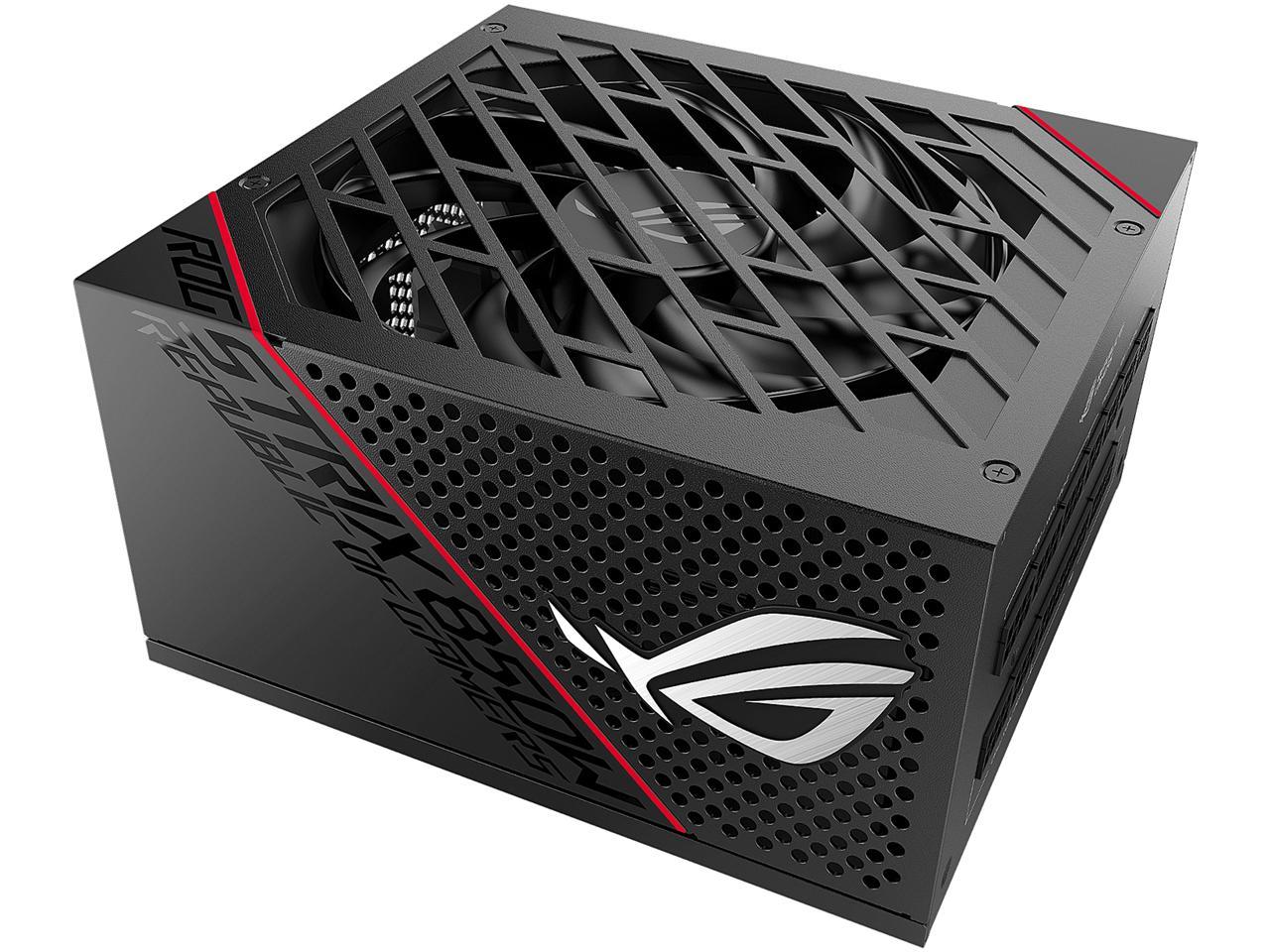Why you can trust Tom's Hardware
To learn more about our PSU tests and methodology, please check out How We Test Power Supply Units.
Primary Rails And 5VSB Load Regulation
The following charts show the main rails' voltage values recorded between a range of 40W up to the PSU's maximum specified load, along with the deviation (in percent). Tight regulation is an important consideration every time we review a power supply because it facilitates constant voltage levels despite varying loads. Tight load regulation also, among other factors, improves the system’s stability, especially under overclocked conditions. At the same time, it applies less stress to the DC-DC converters that many system components utilize.

Results 1-8: Load Regulation


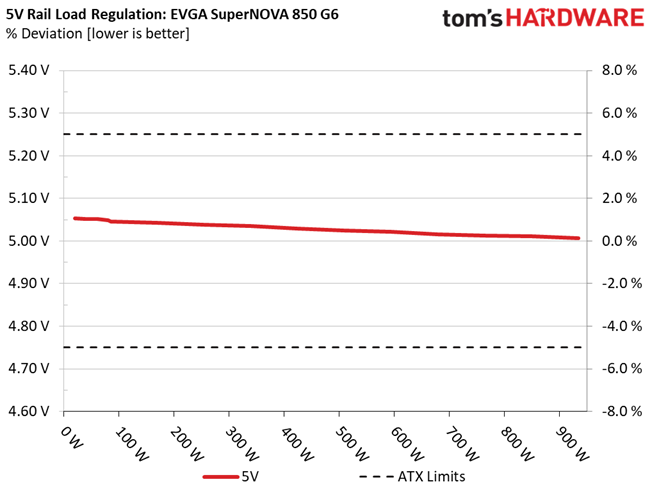


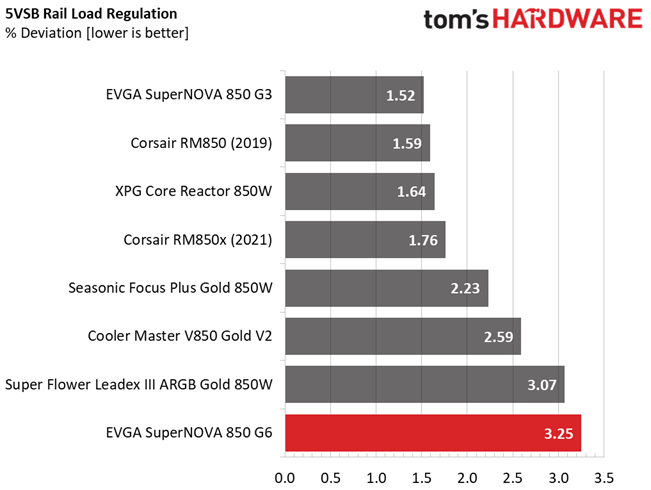

Load regulation is tight enough here at 12V but not even close to the level of theG3 and older Focus Plus Gold 850. That's because there is an increase at 12V at light loads, most likely due to the burst mode operation for high efficiency at these load levels. The minor rails could have tighter load regulation, but 5VSB, although it is in the last place, isn't a problem.
Hold-Up Time
Put simply; hold-up time is the amount of time that the system can continue to run without shutting down or rebooting during a power interruption.

Results 9-12: Hold-Up Time



The hold-up time is very long on this unit, and the same goes for the power ok signal, which is accurate.
Inrush Current
Inrush current, or switch-on surge, refers to the maximum, instantaneous input current drawn by an electrical device when it is first turned on. A large enough inrush current can cause circuit breakers and fuses to trip. It can also damage switches, relays, and bridge rectifiers. As a result, the lower the inrush current of a PSU right as it is turned on, the better.
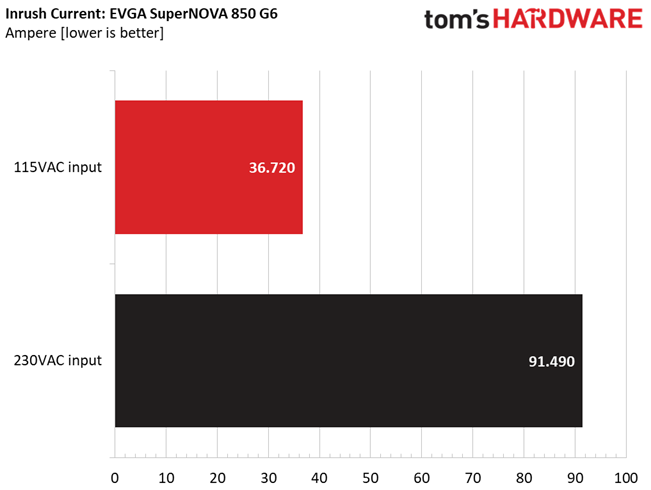
Results 13-14: Inrush Current
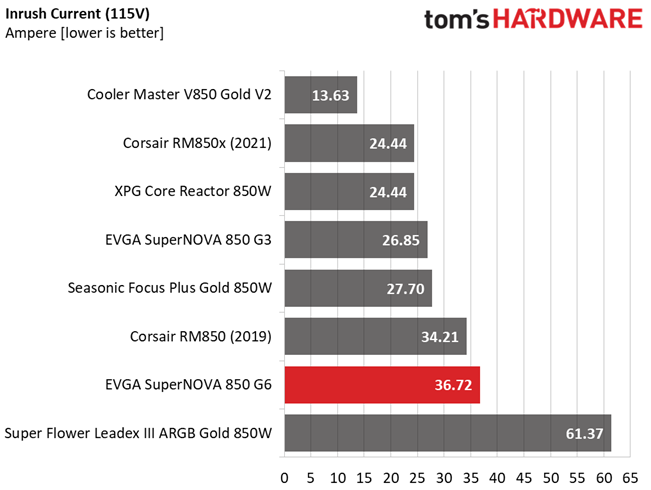
This unit's inrush currents are high at 230V input, which could have been avoided with a larger NTC thermistor.
Get Tom's Hardware's best news and in-depth reviews, straight to your inbox.
Leakage Current
In layman's terms, leakage current is the unwanted transfer of energy from one circuit to another. In power supplies, it is the current flowing from the primary side to the ground or the chassis, which in the majority of cases is connected to the ground. For measuring leakage current, we use a GW Instek GPT-9904 electrical safety tester instrument.
The leakage current test is conducted at 110% of the DUT's rated voltage input (so for a 230-240V device, we conduct the test with 253-264V input). The maximum acceptable limit of a leakage current is 3.5 mA, as defined by the IEC-60950-1 regulation. This ensures that the current is low and will not harm any person coming in contact with the power supply's chassis.

This unit's leakage current is low enough.
10-110% Load Tests
These tests reveal the PSU's load regulation and efficiency levels under high ambient temperatures. They also show how the fan speed profile behaves under increased operating temperatures.
| Test | 12V | 5V | 3.3V | 5VSB | DC/AC (Watts) | Efficiency | Fan Speed (RPM) | PSU Noise (dB[A]) | Temps (In/Out) | PF/AC Volts |
| 10% | 5.215A | 1.982A | 1.981A | 0.982A | 85.018 | 83.812% | 591 | 11.8 | 40.58°C | 0.962 |
| 12.160V | 5.045V | 3.332V | 5.09V | 101.439 | 44.65°C | 115.14V | ||||
| 20% | 11.450A | 2.976A | 2.975A | 1.182A | 169.992 | 88.921% | 591 | 11.8 | 40.87°C | 0.973 |
| 12.148V | 5.042V | 3.328V | 5.075V | 191.171 | 45.47°C | 115.14V | ||||
| 30% | 18.052A | 3.474A | 3.475A | 1.383A | 255.016 | 90.082% | 592 | 11.9 | 41.32°C | 0.974 |
| 12.130V | 5.038V | 3.324V | 5.062V | 283.093 | 46.66°C | 115.14V | ||||
| 40% | 24.653A | 3.973A | 3.975A | 1.585A | 340.125 | 90.415% | 589 | 11.8 | 41.74°C | 0.979 |
| 12.125V | 5.035V | 3.321V | 5.049V | 376.183 | 47.56°C | 115.13V | ||||
| 50% | 30.920A | 4.972A | 4.976A | 1.788A | 425.198 | 90.013% | 1391 | 39.2 | 42.02°C | 0.982 |
| 12.118V | 5.029V | 3.316V | 5.033V | 472.374 | 48.37°C | 115.13V | ||||
| 60% | 37.145A | 5.972A | 5.978A | 1.993A | 509.702 | 89.597% | 1393 | 39.3 | 42.67°C | 0.984 |
| 12.111V | 5.025V | 3.313V | 5.018V | 568.884 | 49.65°C | 115.12V | ||||
| 70% | 43.442A | 6.973A | 6.981A | 2.199A | 595.024 | 88.996% | 1395 | 39.4 | 43.24°C | 0.986 |
| 12.105V | 5.021V | 3.31V | 5.004V | 668.597 | 51.21°C | 115.12V | ||||
| 80% | 49.739A | 7.978A | 7.987A | 2.304A | 679.86 | 88.302% | 1754 | 45.9 | 43.69°C | 0.987 |
| 12.102V | 5.016V | 3.306V | 4.992V | 769.926 | 52.15°C | 115.11V | ||||
| 90% | 56.428A | 8.481A | 8.48A | 2.411A | 765.281 | 87.672% | 1758 | 45.9 | 44.76°C | 0.989 |
| 12.100V | 5.013V | 3.302V | 4.979V | 872.887 | 53.77°C | 115.11V | ||||
| 100% | 62.856A | 8.985A | 9.004A | 3.028A | 850.092 | 86.815% | 1761 | 45.9 | 45.51°C | 0.99 |
| 12.097V | 5.011V | 3.299V | 4.955V | 979.2 | 55.26°C | 115.1V | ||||
| 110% | 69.137A | 9.989A | 10.103A | 3.035A | 934.664 | 85.892% | 1764 | 46.0 | 46.92°C | 0.99 |
| 12.097V | 5.007V | 3.296V | 4.944V | 1088.185 | 57.67°C | 115.1V | ||||
| CL1 | 0.116A | 14.316A | 14.272A | 0A | 121.335 | 82.205% | 1406 | 40.0 | 42.11°C | 0.98 |
| 12.167V | 5.045V | 3.342V | 5.091V | 147.599 | 48.22°C | 115.14V | ||||
| CL2 | 0.115A | 23.785A | 0A | 0A | 121.442 | 80.038% | 1747 | 45.7 | 43.22°C | 0.98 |
| 12.160V | 5.047V | 3.324V | 5.098V | 151.731 | 49.86°C | 115.14V | ||||
| CL3 | 0.115A | 0A | 23.61A | 0A | 80.592 | 74.938% | 1744 | 45.6 | 44.9°C | 0.964 |
| 12.153V | 5.042V | 3.354V | 5.095V | 107.545 | 52.08°C | 115.14V | ||||
| CL4 | 70.264A | 0A | 0A | 0.001A | 849.752 | 87.636% | 1759 | 45.9 | 45.86°C | 0.989 |
| 12.094V | 5.017V | 3.296V | 5.04V | 969.638 | 55.31°C | 115.1V |
The PSU easily handles high loads at increased operating temperatures, but the fan's noise is loud.
20-80W Load Tests
In the following tests, we measure the PSU's efficiency at loads significantly lower than 10% of its maximum capacity (the lowest load the 80 PLUS standard measures). This is important for representing when a PC is idle with power-saving features turned on.
| Test | 12V | 5V | 3.3V | 5VSB | DC/AC (Watts) | Efficiency | Fan Speed (RPM) | PSU Noise (dB[A]) | Temps (In/Out) | PF/AC Volts |
| 20W | 1.228A | 0.495A | 0.495A | 0.195A | 20.015 | 73.631% | 0 | <6.0 | 39.04°C | 0.803 |
| 12.105V | 5.053V | 3.336V | 5.116V | 27.182 | 36.89°C | 115.14V | ||||
| 40W | 2.700A | 0.693A | 0.693A | 0.294A | 40.014 | 79.344% | 0 | <6.0 | 39.89°C | 0.927 |
The fan doesn't spin at light loads, which helps boost efficiency as even a single Watt can notably affect efficiency readings in these tests.
2% or 10W Load Test
From July 2020, the ATX spec requires 70% and higher efficiency at 115V input. The applied load is only 10W for PSUs with 500W and lower capacities, while for stronger units, we dial 2% of their max-rated capacity.
| 12V | 5V | 3.3V | 5VSB | DC/AC (Watts) | Efficiency | Fan Speed (RPM) | PSU Noise (dB[A]) | Temps (In/Out) | PF/AC Volts |
| 1.224A | 0.25A | 0.25A | 0.052A | 17.17 | 72.209% | 0 | <6.0 | 26.35°C | 0.778 |
| 12.093V | 5.047V | 3.333V | 5.12V | 23.778 | 27.73°C | 115.12V |
Efficiency exceeds 70% with 2% load, meeting the corresponding Intel specifications.
Efficiency & Power Factor
Next, we plotted a chart showing the PSU's efficiency at low loads and loads from 10 to 110% of its maximum rated capacity. The higher a PSU’s efficiency, the less energy goes wasted, leading to a reduced carbon footprint and lower electricity bills. The same goes for power factor.

Results 15-18: Efficiency



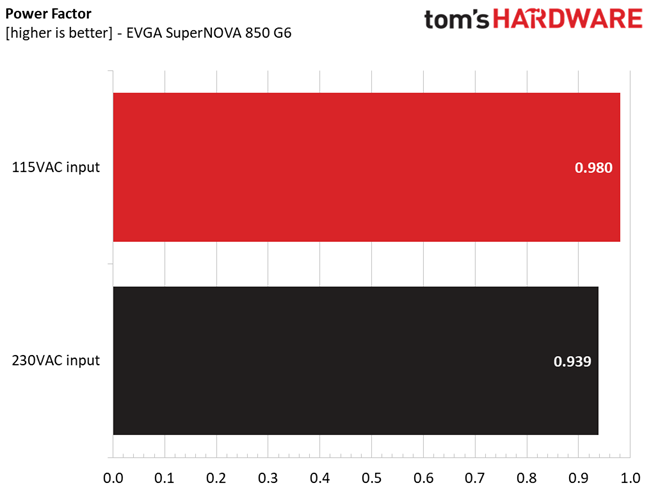
Efficiency is on the low side for normal and light loads, which is always the case with a Gold unit. Only with a 2% load can this PSU manage to take a better place in the graph.
5VSB Efficiency
| Test # | 5VSB | DC/AC (Watts) | Efficiency | PF/AC Volts |
| 1 | 0.1A | 0.512W | 72.352% | 0.066 |
| 5.123V | 0.708W | 115.12V | ||
| 2 | 0.25A | 1.28W | 75.888% | 0.147 |
| 5.119V | 1.687W | 115.12V | ||
| 3 | 0.55A | 2.813W | 77.558% | 0.264 |
| 5.113V | 3.627W | 115.12V | ||
| 4 | 1A | 5.103W | 77.688% | 0.363 |
| 5.102V | 6.569W | 115.12V | ||
| 5 | 1.5A | 7.637W | 77.465% | 0.42 |
| 5.091V | 9.858W | 115.11V | ||
| 6 | 3A | 15.138W | 75.942% | 0.492 |
| 5.045V | 19.934W | 115.12V |
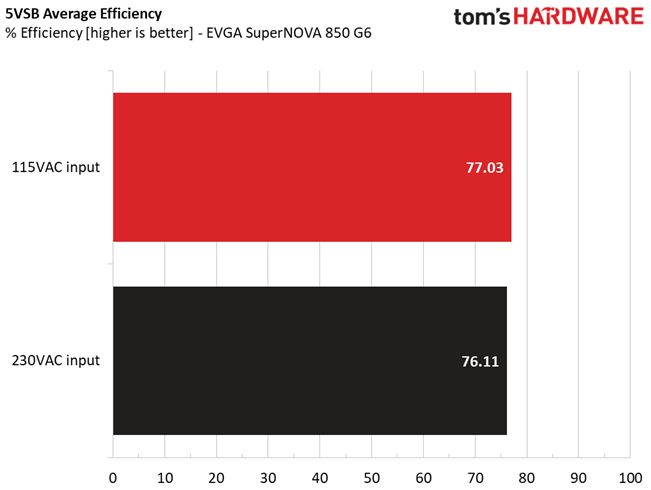
Results 19-20: 5VSB Efficiency

This unit's 5VSB rail is better than the corresponding circuit on the G3 model, but still isn't efficient enough for our liking.
Power Consumption In Idle And Standby
| Mode | 12V | 5V | 3.3V | 5VSB | Watts | PF/AC Volts |
| Idle | 12.089V | 5.045V | 3.332V | 5.124V | 3.677 | 0.264 |
| 115.11V | ||||||
| Standby | 0.059 | 0.005 | ||||
| 115.11V |

Results 21-22: Vampire Power

Vampire power is low enough at 115V, although it doesn't hit the less than 0.1W ideal at 230V input.
Fan RPM, Delta Temperature, And Output Noise
All results are obtained between an ambient temperature of 37 to 47 degrees Celsius (98.6 to 116.6 degrees Fahrenheit).
This PSU's fan speed profile is quite aggressive at high operating temperatures. Given that it is controlled by an MCU, it could stand to have more operation modes to make it smoother.
The following results were obtained at 30 to 32 degrees Celsius (86 to 89.6 degrees Fahrenheit) ambient temperature.
At normal operating temperatures, close to 30 degrees Celsius, the PSU is silent up to 560W loads. Nevertheless, with higher loads it exceeds 30 dBA. The transition between low and mid loads to high ones could be smoother.
MORE: Best Power Supplies
MORE: How We Test Power Supplies
MORE: All Power Supply Content
Current page: Load Regulation, Hold-Up Time, Inrush & Leakage Current, Efficiency and Noise
Prev Page Specifications and Part Analysis Next Page Protection Features, DC Power Sequencing, Cross-Load Tests and Infrared Images
Aris Mpitziopoulos is a contributing editor at Tom's Hardware, covering PSUs.
-
Johnpombrio I own 3 of the EVGA Supernova 850 G2 power supplies with LOTS AND LOTS of extra modular cables 😊. I didn't know that they were legendary, heh. The specs on the side of the PSU are the same as the G6 so I expect that the main difference is the efficiency. I turned on ECO mode and I doubt the fan ever spins.Reply -
taz-nz The biggest improvement is they got rid of the green chrome fan grill from the G5 series.Reply
If it's as reliable as the G2, G3 and G5 series, I look forward to building a lot of PCs with them.
It would be nice if they stepped up their game in cheaper non-modular models, they are significantly lower quality. -
SteelTeel Why is your noise measurement so different from what EVGA posts on its website? Are these measurements carried out with ECO mode enabled?Reply
-
wONKEyeYEs Just picked up a EVGA G1+ 850 W 80+ Gold.Reply
If anything goes wrong I know that I can count on EVGA's
excellent service.


